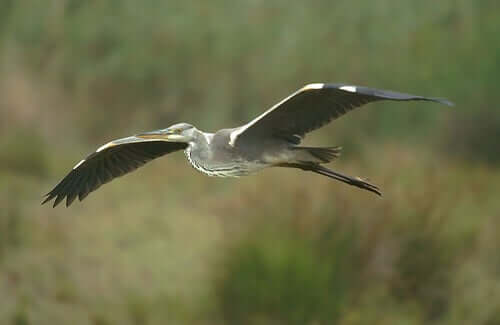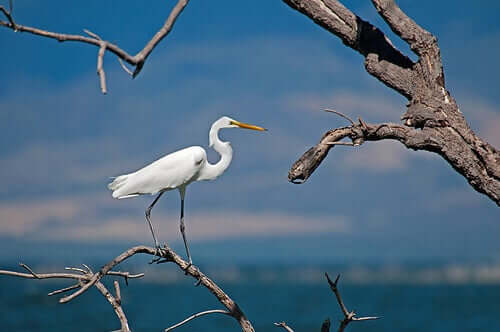Grey Heron: Characteristics, Behavior, and Habitat

This bird comes from Eurasia and Africa and prefers to live around rivers, lakes, or freshwater wetlands. They’re found only in temperate regions. In this article, we’ll tell you all about the characteristics, behavior, and habitats of the Grey (Gray) Heron. It’s a truly majestic creature!
Grey heron characteristics
This bird’s scientific name is Ardea cinerea and they’re large birds that can measure over 3 feet tall. Their wingspan is particularly impressive and can be well over 6 feet wide when in flight.
Their plumage is made up of a lighter gray color on the wings and white areas on the head and neck. They also have a long, straight orange or yellow beak with a point at the end for catching food.

Their legs are dark and very thin, like a flamingo’s, and their eyes have yellow irises.
Behavior and reproduction
The grey heron’s long neck allows it to fly with an ‘S’ between the beak and shoulders. This is quite different from storks and cranes, which keep their necks extended. They beat their wings slowly and can glide great distances. Sometimes they climb in a circular pattern in the air depending on the air currents and winds.
As well as a few hours in flight, grey herons also spend much time perched on tree branches or roaming on the ground or along rivers. When in water, they alternate the leg they use as support.
One of the most interesting things about this bird is that it communicates with its fellow herons with varied hoarse guttural sounds. The males call out to their partners almost like a greeting, and they have a special sound they make to expel others from their nests.
Grey herons build their homes in trees near the banks of lakes or wetlands, although you can also find nests among reeds and bushes on riverbanks. To build their nests, first, the male collects small branches to assemble a platform. Then the female lines the interior with grass, fibers, feathers or reeds.
Their reproduction period runs from February to August and mating happens after a greeting ceremony, where couples spread their wings on a reconnaissance flight. They will then lay up to five eggs, which are greenish in color and will be incubated for 25 days.
Once the chicks are born, the parents feed them by regurgitating their food until they are eight weeks old. Then, they have to leave the nest and fend for themselves.

Grey heron habitat and diet
The grey heron belongs to the pelecaniform group of birds. This means that it lives in aquatic ecosystems such as rivers, lakes, and lagoons. They can be found in any of these locations because there they have everything they need. In fact, they’ll never fly further than 12 or 13 miles from their nesting site.
Although they’re more common in low-lying areas, there are certain colonies that we can find on mountain lakes and reservoirs. There are four subspecies of grey heron which inhabit different places, all of them in Europe, Africa and Asia.
As for their diet, they’re carnivorous birds who mainly eat fish, amphibians, insects and small mammals, and they hunt their prey using their long, sharp beaks.
The grey heron can fish whilst on the prowl at both sunrise and sunset. They keep their feet in the water waiting for the ideal moment to lower their neck and snatch their prey.
They also swallow their food whole without chewing. If their food is too big, they’ll hit it against the ground or pierce it with their beak to eat it in smaller chunks.
Images courtesy of Superstringphysics, Ferran Pestaña, and Carlos De Soto Molinari
This bird comes from Eurasia and Africa and prefers to live around rivers, lakes, or freshwater wetlands. They’re found only in temperate regions. In this article, we’ll tell you all about the characteristics, behavior, and habitats of the Grey (Gray) Heron. It’s a truly majestic creature!
Grey heron characteristics
This bird’s scientific name is Ardea cinerea and they’re large birds that can measure over 3 feet tall. Their wingspan is particularly impressive and can be well over 6 feet wide when in flight.
Their plumage is made up of a lighter gray color on the wings and white areas on the head and neck. They also have a long, straight orange or yellow beak with a point at the end for catching food.

Their legs are dark and very thin, like a flamingo’s, and their eyes have yellow irises.
Behavior and reproduction
The grey heron’s long neck allows it to fly with an ‘S’ between the beak and shoulders. This is quite different from storks and cranes, which keep their necks extended. They beat their wings slowly and can glide great distances. Sometimes they climb in a circular pattern in the air depending on the air currents and winds.
As well as a few hours in flight, grey herons also spend much time perched on tree branches or roaming on the ground or along rivers. When in water, they alternate the leg they use as support.
One of the most interesting things about this bird is that it communicates with its fellow herons with varied hoarse guttural sounds. The males call out to their partners almost like a greeting, and they have a special sound they make to expel others from their nests.
Grey herons build their homes in trees near the banks of lakes or wetlands, although you can also find nests among reeds and bushes on riverbanks. To build their nests, first, the male collects small branches to assemble a platform. Then the female lines the interior with grass, fibers, feathers or reeds.
Their reproduction period runs from February to August and mating happens after a greeting ceremony, where couples spread their wings on a reconnaissance flight. They will then lay up to five eggs, which are greenish in color and will be incubated for 25 days.
Once the chicks are born, the parents feed them by regurgitating their food until they are eight weeks old. Then, they have to leave the nest and fend for themselves.

Grey heron habitat and diet
The grey heron belongs to the pelecaniform group of birds. This means that it lives in aquatic ecosystems such as rivers, lakes, and lagoons. They can be found in any of these locations because there they have everything they need. In fact, they’ll never fly further than 12 or 13 miles from their nesting site.
Although they’re more common in low-lying areas, there are certain colonies that we can find on mountain lakes and reservoirs. There are four subspecies of grey heron which inhabit different places, all of them in Europe, Africa and Asia.
As for their diet, they’re carnivorous birds who mainly eat fish, amphibians, insects and small mammals, and they hunt their prey using their long, sharp beaks.
The grey heron can fish whilst on the prowl at both sunrise and sunset. They keep their feet in the water waiting for the ideal moment to lower their neck and snatch their prey.
They also swallow their food whole without chewing. If their food is too big, they’ll hit it against the ground or pierce it with their beak to eat it in smaller chunks.
Images courtesy of Superstringphysics, Ferran Pestaña, and Carlos De Soto Molinari
This text is provided for informational purposes only and does not replace consultation with a professional. If in doubt, consult your specialist.








